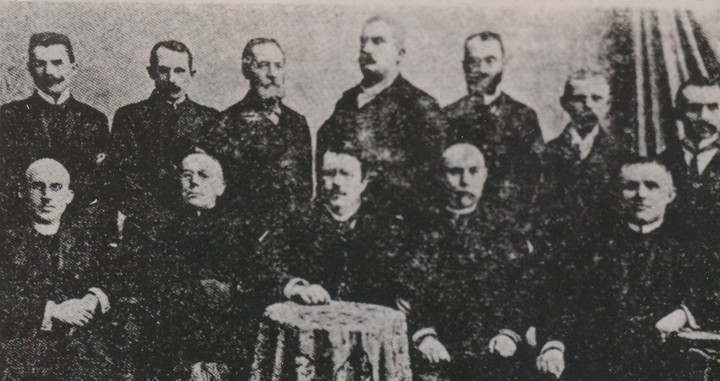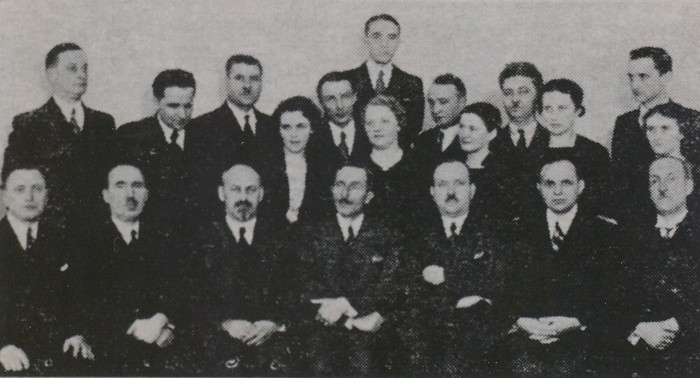Silskyi Hospodar
Silskyi Hospodar [Сільський Господар; Farmer]. The most important Ukrainian agricultural organization in Galicia. In was founded in 1899 in the town of Olesko, Zolochiv county, by Revs T. and Yuliian Dutkevych with the goal of raising the living standard of the peasantry by improving agriculture and agricultural education. Initially the organization limited its activities to the Zolochiv region (Brody county and Olesko judicial district). In 1903 its headquarters was transferred to Lviv, and in 1904 it was reorganized into the Silskyi Hospodar Provincial Agricultural Society with a mandate to organize branches throughout Galicia. The organization grew slowly: in early 1909 it had only five branches and 700 members.
The rapid development of Silskyi Hospodar (SH) began with the first agricultural exhibition, organized in 1909 in Stryi by the Prosvita society. At the annual meeting of SH held during the exhibition, its statute was amended to expand its range of activities and restructure it into a three-tiered organization, with a central office, county branches, and village locals. At the same time Yevhen Olesnytsky replaced T. Dutkevych as president of SH. Assisted by Stepan Onyshkevych and Hryhorii Velychko, he extended the organization's activities to all parts of Galicia and took over almost all agricultural work formerly done by the Prosvita society and by various co-operatives. In 1910 SH had 85 branches, 317 locals, and 12,500 members.
SH acted as the legal representative of Ukrainian peasants before the government. It organized courses and lectures for agricultural instructors and farmers; established research stations and model farms, orchards, apiaries, and livestock and poultry farms; instructed peasants about agricultural machinery and equipment, the collective use of machines, and effective land management; and organized a school of orcharding and farming. It published the journal Hospodars’ka chasopys’ (1910–18, 1920) and 27 brochures in its book series. In 1911 it established a syndicate for the distribution and sale of farm products (see Tsentrosoiuz) and the Provincial Union for the Breeding and Raising of Livestock. Profits from those two organizations were used to fund SH's other activities.
The First World War interrupted the operations of Silskyi Hospodar. In 1915 it began to rebuild its facilities. The effort was assisted financially by the Austrian government, which recognized the organization as the central union of Ukrainian peasants. From the end of 1918 until May 1919 it functioned in the areas controlled by the Western Ukrainian National Republic, which granted it official recognition. After the consolidation of Polish rule in Galicia, SH operations were suspended for a brief period.
SH resumed its activities in 1920, but on a very limited scale. The number of branches fell drastically (in 1924 there were only 10), and its new organ, Hospodars’ko-kooperatyvnyi chasopys, was taken over by the Audit Union of Ukrainian Co-operatives (RSUK). From 1927 it increased its activity quickly, supported by the Association of Ukrainian Agronomists and various Ukrainian co-operatives, which provided funds. In 1929 SH was reorganized. A board of directors, headed by Yuliian Pavlykovsky (1924–9), Tyt Voinarovsky-Stolobut (1929–36), and Myron Lutsky (1936–9), was responsible for its general policy. The administration was left to the chairman, Yevhen Khraplyvy (1928–39), and his executive, which included M. Kholievchuk, Illia Lapchuk, I. Lysy, B. Hnatevych, and A. Romanenko. The primary goal of the organization was to provide peasants with theoretical and practical training in agriculture. The most significant development in that area was the introduction of the Khliborobskyi Vyshkil Molodi program in 1932. A section of SH organized courses in home economics for peasant women. Formed in 1936, the section was headed by Olena Kysilevska, assisted by Iryna Pavlykovska. Its organizers included Kharyta Kononenko and I. Dombchevska.
SH published several periodicals: Sil’s’kyi hospodar, Ukraïns’kyi pasichnyk, Praktychne sadivnytstvo (1933–8, edited by Mykhailo Borovsky), Khliborobs’ka molod’, and Sad i horod (1939). During its history it published almost 180 textbooks and popular manuals on all aspects of agriculture, almost 120 of them in the interwar period. From 1928 SH issued an annual calendar, and just before the outbreak of the Second World War it began to publish an agricultural encyclopedia, edited by Yevhen Khraplyvy. SH also printed hundreds of pamphlets, leaflets, and posters. In the interwar period it operated eight model farms, an agricultural school in Korshiv, and an advanced school in Yanchyn, where instructors and assistant agronomists were trained. The growth of SH is summarized in the following table.
SH attempted to extend its activities to Volhynia during the interwar period, and from 1928 it operated a branch in Lutsk, directed by Volodymyr P. Ostrovsky and then R. Klos, but the branch was closed by the Polish authorities in 1937. For a short period SH also maintained a branch in Kremenets, directed by Borys Kozubsky. Throughout the period SH worked closely with Audit Union of Ukrainian Co-operatives, sometimes sharing personnel and facilities.
In 1939 the Soviet authorities liquidated SH. It continued its work in the German-occupied Generalgouvernement and established a headquarters in Jarosław (directed by Leonyd Bachynsky and M. Kaplysty). In practice its work was limited to the peasants of the region. That office published 17 issues of the monthly Sil’s’kyi hospodar, several booklets, and a calendar. A regional SH organization was established in Cracow in 1940–1 and was affiliated with the Ukrainian Central Committee. It included 130 locals in the Lemko region and Sian region.
When all of Galicia was occupied by the Germans in 1941, SH renewed its activity in Lviv under the presidency of Yevhen Khraplyvy and the directorship of Ja. Zajszlyj. It worked closely with the Lviv Agricultural Chamber, which was directed by Khraplyvy, and was recognized as the main professional association of Ukrainian farmers. It renewed the publication of Sil’s’kyi hospodar and Ukraïns’kyi pasichnyk and issued a few booklets and calendars. With the second Soviet occupation of Galicia in 1944, SH was dissolved.
SH not only improved the economic standing of the Ukrainian peasantry but also did much to raise their national consciousness. Among its prominent activists, in addition to ones already mentioned, were O. Duchyminska, Petro Zeleny, Mykhailo Khronoviat, Mykola Tvorydlo, and V. Vakulovsky.
BIBLIOGRAPHY
Dubrivnyi, P. (ed). Kraiove hospodars’ke tovarystvo ‘Sil’s’kyi hospodar’ u L’vovi, 1899–1944 (New York 1970)
Petro Zeleny
[This article originally appeared in the Encyclopedia of Ukraine, vol. 4 (1993).]

.jpg)
